 Click on any image for a larger version. |
 Recently I did two of the coolest thingsI’ve ever done in an airplane. I didn’t get to see either one of them and together theytook less than five seconds.
Recently I did two of the coolest thingsI’ve ever done in an airplane. I didn’t get to see either one of them and together theytook less than five seconds.
What could possibly be this exciting? One day I arrived on the deck of the USS John C.Stennis via arrested landing. The following day I was shot via catapult back to terrafirma. I didn’t see either one because like a bag of mail, a replacement part, or atransferring yeoman, I flew in a C-2 Greyhound with the acronym COD (carrier onboarddelivery).
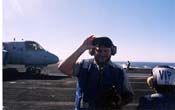 DidI enlist? No. I spent about 26 hours on the Stennis watching pilots get carrier qualifiedover two days. The Stennis was about 200 miles southwest of San Diego in internationalwaters. On January 7, 2000, the ship will deploy for a six-month cruise to the MiddleEast. On day one of my visit the crew of the Stennis logged 165 day traps and 53 nighttraps. That’s a record for the Stennis. It’s also about a 17-hour day, which is notuncommon in training and a relatively short day when she’s working on station.
DidI enlist? No. I spent about 26 hours on the Stennis watching pilots get carrier qualifiedover two days. The Stennis was about 200 miles southwest of San Diego in internationalwaters. On January 7, 2000, the ship will deploy for a six-month cruise to the MiddleEast. On day one of my visit the crew of the Stennis logged 165 day traps and 53 nighttraps. That’s a record for the Stennis. It’s also about a 17-hour day, which is notuncommon in training and a relatively short day when she’s working on station.
What I was invited to is officially called a Distinguished Visitor (DV) tour.Apparently the Navy has a loose interpretation of who’s "distinguished" and theoccasional flib driver like yours truly is able to sneak in. [NOTE:"Flib" is a term of endearment used by air traffic controllers. In contrast toairliners who operate on scheduled routes and times, a small plane is a FunnyLittle Itinerant Blip.]
My group of 16 was mostly judges and politicos from southern California. The previousday’s group had been mostly educators from UCLA. The Navy offers these tours almost dailywhen the ship is within COD range because they’re proud of how hard they’re working andthey want people to know about it and tell others. As this bull market rages on, asAmerica’s entrepreneurial spirit turns deficits into surpluses, the Navy is livingpaycheck to paycheck. I can’t speak for the whole Navy, but I can tell you that on theStennis, they’re giving Sam a dollar’s work for about two bits’ pay.
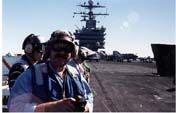 I was invited by aviation artist Stan Stokes, who is a walkingencyclopedia of naval aviation and WWII history. Remember the Marshall McLuhan scene in AnnieHall? That’s what it’s like taking a trip with Stan. When you need the definitiveanswer, he has it. Tail numbers, pilots, crews, kills, routes, how many rivets on the tailof a Dauntless … if it’s ever a Jeopardy category he’s a lock. You’ll recognize Stanright away at future aviation events as the guy with the cleanest car. That’s because topay him back for this invitation I’ve promised to wash and wax his car every Saturday forthe rest of my life.
I was invited by aviation artist Stan Stokes, who is a walkingencyclopedia of naval aviation and WWII history. Remember the Marshall McLuhan scene in AnnieHall? That’s what it’s like taking a trip with Stan. When you need the definitiveanswer, he has it. Tail numbers, pilots, crews, kills, routes, how many rivets on the tailof a Dauntless … if it’s ever a Jeopardy category he’s a lock. You’ll recognize Stanright away at future aviation events as the guy with the cleanest car. That’s because topay him back for this invitation I’ve promised to wash and wax his car every Saturday forthe rest of my life.
The Ride Out
Our DV visit began at San Diego’s North Island Naval Air Station with a rampsidebriefing by the flight crew. As the anticipation built, we donned "Mae West"flotation vests. Then we added a "cranial" which is a contraption that combinesskull protection, eye protection and ear protection. From there until you’re safely aboardship and below the deck, hand signals are the means of communication. Pretty soon we wereled off to the waiting C-2, with one prop spinning and the other shut down. Filled withanticipation, we boarded the airplane via the rear ramp and grabbed a seat.
 On board we got another brief on how to evacuate in the unlikely event ofa water landing. The 19-year-old Marine pointed to the small square escape hatch on theroof of the airplane and said something like "just pull these two hinges to removethe door and reach up and pull yourself out." The idea of a chin-up through a smallescape hatch made sense to the Marine, but in the shape I’m in I figured in the event theunlikely event happens, I’d become shark bait.
On board we got another brief on how to evacuate in the unlikely event ofa water landing. The 19-year-old Marine pointed to the small square escape hatch on theroof of the airplane and said something like "just pull these two hinges to removethe door and reach up and pull yourself out." The idea of a chin-up through a smallescape hatch made sense to the Marine, but in the shape I’m in I figured in the event theunlikely event happens, I’d become shark bait.
The COD has 30 seats and they all face backwards. There’s one puny window in thepassenger area, but 90% of the time you’d see a little sliver of water anyway. Nobody wascomplaining … not like we could hear them if they had. This was my first time taxiingblind and backwards. I’ve taxied in the fog, at night, and in the fog at night, and I didtaxi sideways once with a marginal view when John Deakin offered me a ride in CAF’s C-46China Doll, but this was my first time blind and backwards. Soon the engines went to fullpower and we were flying.
It took a little less than an hour to reach the ship. The flight was as routine as aflight can be with 30 people sitting backwards in relative darkness wearing helmets,headphones and goggles. No one’s ever going to mistake this form of travel for businessclass.
The Marine waved his arm, which was our signal to settle in for the arrested landing.When you’re facing backwards, there isn’t much bracing to do because … the forceis with you. Maybe not for long, but at least long enough to push you into the seatback.After what seemed like an eternity on final, we slammed into the deck at 165 knots andcame to a stop in about 300 feet. I spend a lot of time at 165 knots … that’s about allI can coax out of my Bellanca Viking on a good day. The thought of stopping my Viking fromcruise speed on a football field is beyond my ability to imagine. Not to mention that theC-2 weighs about 50,000 pounds more than my Viking.
What is it like? It’s like that sudden deceleration feeling near the end of a rollercoaster ride … with a thousand times the force … a hundred times faster … facingbackwards. I’m not normally one to scream at rock concerts or sports events, but Iremember letting out a good howl as we citizens were arrested. Soon we were exiting theairplane onto the carrier flight deck.
Topside
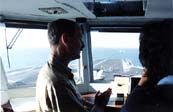 Our group was led into the Captain’s mess where we met our host, CaptainRichard K. Gallagher, Commanding Officer of the Stennis. Capt. Gallagher took command ofthe ship in late August and will stay with her about a year and a half. He came from theminesweeper USS Inchon and led the Navy Fighter Weapons School (aka TOPGUN) in ’93-’94.Captain Gallagher is a Tomcat guy with the nickname "Weasel." He logged a lot ofhis 4,000 flight hours and 700 carrier traps in the F-14A and F-14B.
Our group was led into the Captain’s mess where we met our host, CaptainRichard K. Gallagher, Commanding Officer of the Stennis. Capt. Gallagher took command ofthe ship in late August and will stay with her about a year and a half. He came from theminesweeper USS Inchon and led the Navy Fighter Weapons School (aka TOPGUN) in ’93-’94.Captain Gallagher is a Tomcat guy with the nickname "Weasel." He logged a lot ofhis 4,000 flight hours and 700 carrier traps in the F-14A and F-14B.
Here’s an interesting factoid: The Navy is averaging about 50 years of service from itsfleet of carriers. The Stennis was commissioned in 1994. At fifty years of service, thelast captain of the Stennis hasn’t been born yet. Captain Gallagher put us in the hands ofLt. Dave Oates, the public affairs officer of the Stennis, and after a quick lunch we wereback topside to visit the catapult.
Someone controls every inch of this floating airport and you can tell what they do bythe color of their vest. Yellow shirts direct aircraft in motion. White shirts handleinspections and safety. Green shirts handle the hardware of wires and tailhooks. Brownshirts are captains of a particular aircraft. Blue shirts run the tugs and chock and chainairplanes. Purple shirts handle fuel. Red shirts handle ammo. And silver suits are thefiremen.
Topside, we again suited up in flotation vests and cranials. Lt. Oates handed us to theAir Bos’n who walked us out to the bow. On the way we passed behind the back of an idlingF-14 and got a nice blast of heat and smell of burnt JP-5 jet fuel that is pretty commonon the cramped real estate of a carrier. You’re always walking in front of something,behind something, or next to something.
The sea was very calm throughout our visit. That’s part of the reason for the recordnumber of traps. When the ship is pitching in the waves planes have to be timed to launchon an up-pitch, and there are more wave-offs as airplanes approach to land. During ourvisit, the Stennis averaged about 14 knots through the water, creating about 25 knots ofwind over the deck. Just about perfect conditions.
In Tension
We stood on the deck and watched cat shots of F-18s, EA-6s, and Air Wing CommanderSherman’s F-14 for about a half hour. Cat shots are an amazing blend of art and science,man and machine. Here’s a nickel’s worth of how it happens.
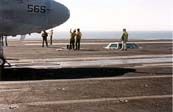 Guided by a yellow shirt, the airplane taxies onto the cat track, like aslingshot dragster inching up to the start line. A green shirt stationed at the nose gearmakes sure that one bar attaches to the catapult and another attaches to the tension bar.A second green shirt verifies the hookup. Then the airplane powers up and sits there"in tension," waiting to be launched. Both green shirts do a final inspectionand roll out from under the airplane. The pilot salutes, the yellow shirt kneels, touchesthe deck with one hand and points to the bow with the other.
Guided by a yellow shirt, the airplane taxies onto the cat track, like aslingshot dragster inching up to the start line. A green shirt stationed at the nose gearmakes sure that one bar attaches to the catapult and another attaches to the tension bar.A second green shirt verifies the hookup. Then the airplane powers up and sits there"in tension," waiting to be launched. Both green shirts do a final inspectionand roll out from under the airplane. The pilot salutes, the yellow shirt kneels, touchesthe deck with one hand and points to the bow with the other.
Peering out the windows of the hexagon-shaped "bubble," the launch officerpresses a button that releases steam into a tube. The steam drives two huge pistons towardthe front of the ship and the airplane goes from a dead stop to about 160 knots in abouttwo seconds. One one thousand, two one thousand. Zero to 160. Once an airplane islaunched, an eerie calm prevails for a few seconds before it all begins again. Thepictures don’t capture the endless roar, the smell, the wind, the heat, and the angst.
The force of the catapult changes from airplane to airplane. The specific setting isbased on the type and the weight of what that airplane is carrying on that sortie. Thelaunches cause the metal on the catapult to expand, so that’s factored in, too. After thepistons launch the airplane they hit a water brake, a tube of water, that stops them infive feet. It takes about a minute and 45 seconds to load and launch a plane.
Three Wire
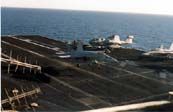 We went back inside, watched a few more cat shots from the quietsanctity of the bridge, then went back outside to an observation deck to watch traps forabout a half hour.
We went back inside, watched a few more cat shots from the quietsanctity of the bridge, then went back outside to an observation deck to watch traps forabout a half hour.
Thanks to a Frenchman named Fresnel, landing airplanes use a VASI-type lens todetermine their glide path. When an amber light lines up with a row of green lights, thepilot will "call the ball" and get landing clearance from the Landing SignalOfficer (LSO) at the stern of the ship. Pilots approach at about 165 knots and the ship ismoving at about 15 knots, so the touchdown speed is around 150. After touchdown pilots goto full power, in case the wire breaks or they "bolter" — i.e., miss thewires — and go around.
There are four arresting cables and the "three wire" is the target. Hittingthe three means you kept the airplane on the glidepath all the way to the deck. Hittingthe one and two means you were a little low and perhaps a little to anxious to get back ondeck. Hitting the four means you were perhaps a little reluctant to get back on deck. Missthe four and you bolter. There’s a five-inch metal triangle on the deck of the ship thatpilots are "aiming for."
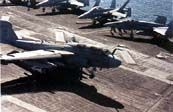 Thegood news about a floating runway is that during traps, the Captain can keep the angledlanding area pointed into the wind. Landing on a football field is hard enough withoutfactoring in a crosswind. The bad news is that the floating airport may be in rough seas,so the runway elevation may be changing from moment to moment.
Thegood news about a floating runway is that during traps, the Captain can keep the angledlanding area pointed into the wind. Landing on a football field is hard enough withoutfactoring in a crosswind. The bad news is that the floating airport may be in rough seas,so the runway elevation may be changing from moment to moment.
I’m sure that, like anything else, experience brings a level of confidence andproficiency that challenges you to always shoot for the best. And, when the air wing is onboard the carrier, each landing is graded and logged on a board in the pilots’ ready roomfor the duration of the cruise. So peer pressure is enormous. But, standing on the deckthat day watching plane after plane hit the three wire, I kept thinking about the oldsaying that any landing you can walk away from is a good one … and if I were flying, I’dhave been happy just to snag any wire, one through four.
After watching traps it was back inside for a tour of the ship.
Buns Of Steel
There are elevators on the ship, but they’re for the aircraft and the ammo. If youdon’t fly or explode, you take the stairs. Here’s a rule of thumb: Wherever you are on theship, the place you want to go next is at least four flights of stairs up or down and atthe extreme other end of the ship. Count on it. After several hundred flights of stairs,it became clear to me why that escape hatch in the COD was so small. Another factoid: Themost popular exercise machine on the ship is the Stairmaster. You see them tucked away in… stairwells.
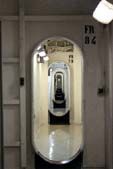 We spent the rest of the afternoon getting in the way all over the ship.We saw the radar rooms, the war rooms, the tool shop, the aircraft hangar bay, theforecastle (pronounced "FOLK-sell"), the ready rooms, the catapult bubble, thevarious messes, the Senator John C. Stennis room, the library, the chapel, and endlesshallways and stairways.
We spent the rest of the afternoon getting in the way all over the ship.We saw the radar rooms, the war rooms, the tool shop, the aircraft hangar bay, theforecastle (pronounced "FOLK-sell"), the ready rooms, the catapult bubble, thevarious messes, the Senator John C. Stennis room, the library, the chapel, and endlesshallways and stairways.
I lived in Chicago for about ten years, and once you learn the grid system there you’renever lost. It’s a miniature version of lat and long. Similarly, every spot on the shiphas a three-dimensional coordinate, called a bullet point. They’re stenciled on the wallsabout every hundred feet or so. A glance tells you immediately which level you’re on, howfar forward or aft, and how far port or starboard from the ship’s centerline. There arealso numbers on each frame (wall) that indicate how far you are from the bow.
The only two areas we didn’t see were munitions and the nuclear reactors. CaptainGallagher not only runs a floating airport, he runs a floating nuclear plant. The day weleft, the Stennis began three days of tests of those systems. CVN stands for CarrierVessel Nuclear. They’re more expensive to build, but less expensive to operate over time.The Navy currently has eight Nimitz-class CVs and its ninth, the USS Reagan, is beingbuilt. The Stennis carries 3,000,000 gallons of fossil fuel, and all of it can be used forthe aircraft. Everything on the ship from steam catapults and arresting cables to radarscopes and hallway lights — all of it — is powered by two grams of Uranium a day.
Ops In The Dark
Like any airport in a major city, activity doesn’t slow down on the flight deck of theStennis when the sun sets. The shirts use flashlights for their hand signals, but thetraffic keeps moving. After dinner, we visited the primary flight (Pri Flight) deck and —bathed in red light — watched about 40 cat shots and about 25 traps. It’s not that wemisplaced 15 airplanes … it’s that many of the launches that night were pilots who hadfinished their qualification and were heading back to land. Some back to nearby NAS NorthIsland and MCAS Miramar, some all the way up the west coast to NAS Whidbey Island.
One EA-6 pilot had to wait for another pilot for finish with his airplane before hecould begin, which meant that by about 2300 hours, the whole flight deck and the radarrooms were still active for one lonely guy as he completed his shots and traps. The AirBoss summed it up: "No matter what you do, there’s always a last guy." Two C-60helicopters are always airborne, flying donuts around the ship, whenever shots or trapsare in progress. They’re there to fetch pilots who eject or photgraphers who falloverboard changing lenses.
The helos made an interesting approach. Their descent rate was about 500 fpm but theirairspeed of about 60 knots surprised me. Figuring that the ship was cruising at about 15,they landed at about 45.
Both Stan and I tried shooting ASA 800 film from the Pri Flight deck and nothing worthlooking at turned out. What you see on the cat end is an F-18 taxiing in the dark. Lightsoff, the airplane hooks to the shuttle. The pilot powers up and the two GE engines lookwhite hot sitting in tension. The pilots signals "ready" by turning lights on,and the two white lights disappear into the night sky. On the arrival end, you see alanding light several miles out. A TV monitor in Pri Flight displays the airplane’s speed,its distance from the ship, and its descent rate. The descent rate for the airplanes I sawwas about 800 fpm. At 160 knots that’s about a 5% glidepath.
At about 2345, I remember wondering if I would get a good night’s sleep. I rememberwalking to my room. I remember climbing into the upper bunk. I remember turning out thelights. That’s all I remember until reveille at 0600.
Day Two Brings Deep Thoughts…
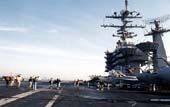 Thelast guy from the night before really was the last guy. With everyone qualified, the deckwas quiet on day two, which gave us the chance to walk around topside. A few deep andnot-so-deep thoughts that occurred to me as I looked around…
Thelast guy from the night before really was the last guy. With everyone qualified, the deckwas quiet on day two, which gave us the chance to walk around topside. A few deep andnot-so-deep thoughts that occurred to me as I looked around…
Communications … from the bridge the Captain has instant communications with everyonefrom the ensign in the next room to the FAA to the Pentagon to the President, wherever heand his football may be from moment to moment. Think of the encrypted code and the backupsystems. That’s a lot of zeros and ones flying through the air. BTW, the Stennis justinstalled a whole shipload of Dells to front their Information Technology 2000 system. Canthe USS Dell be far behind?
Claustrophobia … I couldn’t spend six months on a ship. Period. Yeah, I know they’vegot email and Internet access. Yeah, I know they can call home. Still couldn’t do it.Maybe, if they let me fly off every day, then maybe I’m good for a long weekend, tops. Twohours in a movie theater is bad enough. A half hour if it’s an Adam Sandler film. I’m gladthere are people that can do it. I’m not one of them.
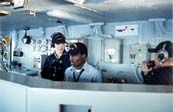 Age … the average age on the flight deck is nineteen and a half. Onceyou spend some time watching them work you realize why. There’s no way a 40-year-old couldkeep up with this pace hour after hour, day after day. Certainly not for the benefitpackage that Sam is offering. Here’s another factoid: These kids have only lived underthree Presidents — Reagan, Bush and Clinton — and they were 11 years old during the GulfWar.
Age … the average age on the flight deck is nineteen and a half. Onceyou spend some time watching them work you realize why. There’s no way a 40-year-old couldkeep up with this pace hour after hour, day after day. Certainly not for the benefitpackage that Sam is offering. Here’s another factoid: These kids have only lived underthree Presidents — Reagan, Bush and Clinton — and they were 11 years old during the GulfWar.
…And Thoughts Of The Deep
Around 1100 we gathered our thoughts and our stuff to head back home and theanticipation started building for our COD cat shot. We assembled to get an officialgoodbye from Captain Gallagher and a departure briefing. Lt. Oates clued us in that themost common error among civilian COD launches is foot placement, so he gave us the"shin briefing." You’re still facing backwards and this time the force is notwith you, so when the cat goes off any unsecured shins will be slammed into the bottom ofthe seat back that you’re facing. At about three Gs, give or take. Marines don’t allowlimping, so the idea is to wedge your legs up onto the seat back and keep them there.
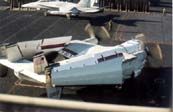 After the briefing, it was back into our Mae Wests and cranials. Alsoback to hand signals for the parade out to the flight deck. We loaded, strapped in, andmade a modified akimbo with our arms, grabbing the opposite shoulder harness with ourhands. Then we waited as the C-2 taxied into place.
After the briefing, it was back into our Mae Wests and cranials. Alsoback to hand signals for the parade out to the flight deck. We loaded, strapped in, andmade a modified akimbo with our arms, grabbing the opposite shoulder harness with ourhands. Then we waited as the C-2 taxied into place.
There wasn’t much to look at, so I closed my eyes. We waited. In my mind I imagined thechoreography of the yellows and the greens I had watched the day before, checking, doublechecking. Throttles went up. The airplane shook in tension as we waited for the yellow tokneel, touch and point. Then it happened.
One one thousand, two one thousand. Zero to 160. As your body takes off, your bloodrushes to stay inside your skin. Adrenaline is plentiful. You can taste it. Then thestrangest sensation hit me for about a second and I hadn’t thought about it ahead of time:Force = Mass x Acceleration. That’s about the extent of what I remember fromhigh-school physics. But when the sense of acceleration stopped I wondered for a moment ifwe were flying. Did something terrible happen? Did they forget to unfold the wings? Wouldwe hit the water and I’d have to chin-up through that hatch after all?
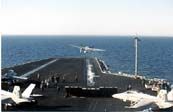 We were flying. Climbing like a bandit, too. I don’t remember opening myeyes. Maybe the blood rush opened them for me. I unwedged my legs and was glad that I hadbeen "shinbriefed." I felt us level off at 5,000 MSL about two minutes into theflight. We landed at NASNI about a half hour later, fetched our luggage, said our goodbyesand thank yous and headed for home.
We were flying. Climbing like a bandit, too. I don’t remember opening myeyes. Maybe the blood rush opened them for me. I unwedged my legs and was glad that I hadbeen "shinbriefed." I felt us level off at 5,000 MSL about two minutes into theflight. We landed at NASNI about a half hour later, fetched our luggage, said our goodbyesand thank yous and headed for home.
Do It Yourself?
How do you arrange for a DV tour? I don’t think there’s one answer. I think it’sdifferent for everybody depending on where you live. The Stennis and the Constellation arebased in San Diego so they get a lot of tours of local folks. Start with yourCongressperson. Maybe find a ship you’re interested in and drop a note to the PAO (publicaffairs officer) of the ship. You’ll find Lt. Dave Oates’s email address, along with statson the ship and Senator Stennis, on the excellent CVN-74website but please don’t flood Dave with requests. They’re already booked for DV toursuntil their deployment in January and he won’t be there after that tour.
I hope you get to do it. Your end of the bargain is to tell other people — taxpayers,voters, legislators — about the dedicated professionals who run the ship. Their end ofthe bargain is to do what they have to do to prepare for war and let you watch. If you’rea pilot and you get a charge out of a few hours at the airport watching folks do touch andgoes, this is absolute nirvana. Not only will I always remember my trap and cat shot, butI got to meet a lot of folks that are working and training hard around the clock to makemy world a more peaceful place.
I’ve left out a lot of detail, stats and history but here are some links that will giveit to you:
and let’s not forget:


































